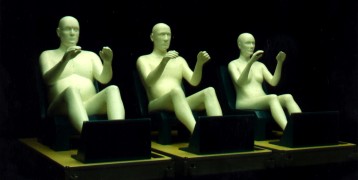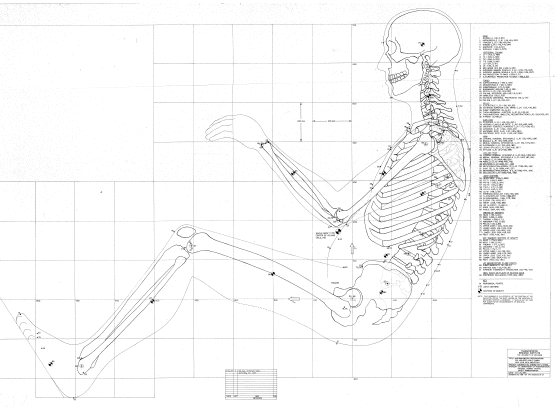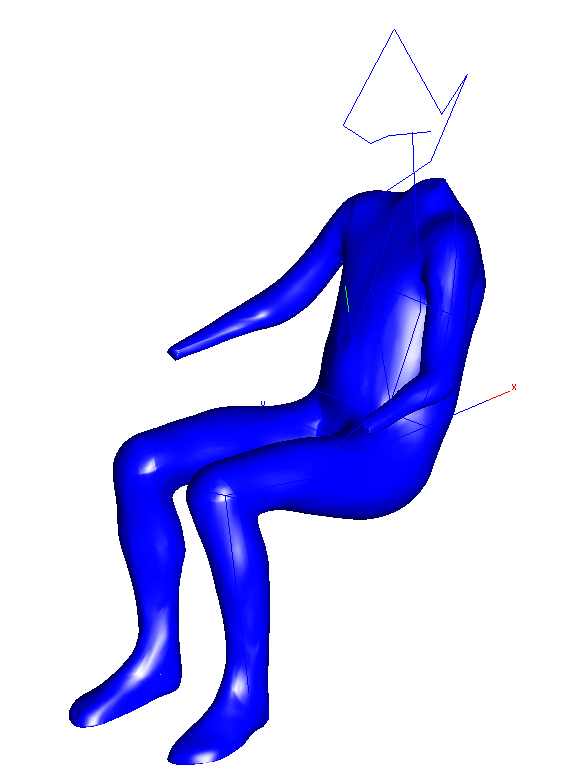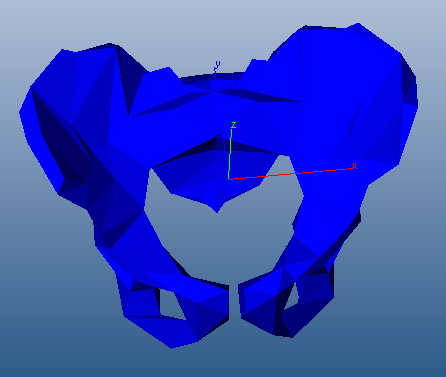>>> Downloads
Downloads
This page lists information from a variety of sources that I have found to be useful. Some of the information is available elsewhere but may be difficult to obtain. This information is either in the public domain or copyrighted by me or the University of Michigan, as far as I know. Note that I have a large amount of related data on anthropometry and vehicle occupant postures, most of which I can make available on request.
If you have questions about the content on this page, please contact me.
- Adult Anthropometry
- Adult Body Shape Models
- 2012 U.S. Army Anthropometry Survey (ANSUR 2)
- 1988 U.S. Army Anthropometry Survey (ANSUR)
- National Health and Nutrition Examination Survey (NHANES)
- Anthropometry of Motor Vehicle Occupants (AMVO)
- Child Anthropometry
- Child Body Shape Models
- UMTRI/CPSC Child Anthropometry Study Data
- UMTRI Child Automotive Anthropometry Study Data
- Child Restraint Geometry
- Airbag Thermal Skin Burn Model
- NHTSA Vehicle Parameter Database
- Reynolds Human Pelvis Geometry Data and Models
Adult Anthropometric Data
I make extensive use of anthropometric databases in my research. Many of these databases are nominally publicly available, but most are not easily obtained on the web. I'm making these available as a public service, but users are cautioned that my versions of these datasets may differ from others. If you find discrepancies, or have a dataset that should be hosted here, please contact me.
For 3D anthropometric data, see our online, interactive model repository at http://humanshape.org/
ANSUR 2 (2012)
A public dataset drawn from the 2012 U.S. Army Anthropometric Survey is now available. I've compiled the methods report, the summary report, and the public datasets here. This sample is improved in all respects from the ANSUR 88 study and should qbe used in place of ANSUR 88. Note that this military population is not likely to be representative of any particular user population, but remains valuable because of the ability to explore interrelationships among the variables. Contact me if you have questions about how best to use these data.
ANSUR 88
An online calculator for ANSUR statistics is available from the Open Design Lab at PSU.
NOTE: ANSUR 2 (2012) is now available and should usually be used in place of ANSUR 88. I've retained ANSUR 88 here to avoid breaking links.
The 1988 U.S. Army Anthropometry survey is one of the most widely used anthropometry databases because of the large number of measures and the rigorous methodology. I extracted the data from public files available from the DTIC, which are in a somewhat cumbersome format. Before using these data, please review the technical report and measurement documentation below. The files are in tab-delimited text format that can be easily imported into any statistical software package for analysis.
- ANSUR Final Report (methods and summary statistics)
- Measurement Definitions
- Data Codes (useful for interpreting categorical data)
- ANSUR Male Data (tab-delimited text)
- ANSUR Female Data (tab-delimited text)
These data are most useful for analyzing relationships between anthropometric variables, since the sample population (U.S. Army as of 1988) is usually not representative of any particular target population. I and others have developed methods to reweight these data to represent alternative populations for which detailed data (e.g., body segment lengths) are not available. The biggest limitation of these data for this purpose is the lack of high-BMI individuals.
If you make use of these data in a publication, please reference the Gordon et al. (1989) final report found above. Feel free to contact me with questions.
NHANES
An online calculator for NHANES statistics is available from the Open Design Lab at PSU.
The U.S. government has conducted periodic nutrition surveys since the early 1960s. Basic anthropometric data have been obtained as part of these studies. The National Health and Nutrition Examination Survey (NHANES) is really a series of surveys that have been conducted since the 1960s. (For more information on NHANES, see the National Center for Health Statistics at the CDC.)
This report from NCHS provides an excellent overview of secular trends in mean stature and weight for U.S. civilians since the 1960s. Mean stature and body weight are both increasing, but body weight is winning by a large margin. The major consequence for engineering anthropometry is that product and workspace dimensions affected by body mass are likely to be affected more by secular trends than are dimensions more closely related to body segment lengths.
Anthropometry of Motor Vehicle Occupants

In the early 1980s, the National Highway Traffic Safety Administration sponsored a study at UMTRI to develop anthropometric criteria for a new generation of crash dummies. The project used standard anthropometry and stereophotogrammetry to create detailed specifications for small-female, midsize-male, and large-male body forms. These data have been widely used for the development of new crash dummies, other tools for vehicle design, and for applications unrelated to vehicles.
The technical reports are available for download here:
Volume 2: Anthropometric Specifications for Mid-Sized Male Dummy
Volume 3: Anthropometric Specifications for Small Female and Large Male Dummies
As part of the ASPECT program, we created CAD surface versions of the three body shells in IGES format:
- Large Male Shell (IGES Format)
- Updated 2024: Midsize Male Shell (IGES Format)
- Small Female Shell (IGES Format)
We also have a large digitized version of the midsize-male side-view drawing, with skeleton. Note that this skeletal rendering has some significant issues (the pelvis is too high, for example). The other drawings are currently available only in hardcopy.

Child Anthropometric Data
For 3D anthropometric data, see our online, interactive model repository at http://humanshape.org/
UMTRI/CPSC Child Anthropometry Study
During the 1970s, Dr. Jerry Snyder and coworkers at UMTRI conducted two large-scale studies of child body dimensions and strength. The data from these studies remain the most widely used child anthropometry data in the U.S. The summary statistics are often cited, but the raw data are more valuable for research. NIST has made these data available in a variety of ways on their AnthroKids website -- I encourage you to visit AnthroKids for a more interactive view of these data. My files were extracted from the original U-M data tapes and so may differ slightly.
Owings et al. 1975: Strength Characteristics of U.S. Children for Product Safety Design (20 MB)
Snyder et al. 1977 Data Archive
Some important cautions about these data: The sample should be adjusted in two ways to represent current U.S. children. First, children are on average slightly heavier at each age than in the 1970s, so the upper percentiles of dimensions that are affected by adiposity have increased. The Snyder data can be reweighted using NHANES to better represent children today. Second, the age distribution has a strong effect on any anthropometric analysis with children. For any particular application, the ages of the children in the target population may differ from the original sample and hence reweighting is necessary. See this recent work for an example of how to reweight these data to represent current child populations. Contact me if you questions about applications of these data.
Child Anthropometry in Automotive Seated Postures
The UMTRI/CPSC data provide a detailed description of "structural anthropometry." These standard body dimensions, obtained in standardized postures, quantify certain aspects of the size and proportions of the body. However, the body dimensions of interest for many applications are dependent on posture. For example, the erect sitting height measure recorded in standard anthropometric studies can differ considerably from the sitting height in task postures. A recent UMTRI study gathered data on the postures of 62 children from 40 to 100 lb sitting on vehicle seats and in belt-positioning boosters. We measured standard anthropometric data and recorded postures in the vehicle-seating conditions using a FARO Arm coordinate measurement machine to digitize the 3-D locations of body landmarks. The data have been used to quantify seat belt fit, to assess the performance of belt-positioning boosters, to evaluate the fidelity of crash dummy dimensions, and to develop new crash-dummy seating procedures. The data from this study are available in a Microsoft Access database. We can make the data available in other formats as well. Contact me for more information about this study.
UMTRI Child Automotive Anthropometry Study Database (71 MB Zip)
Occupant Classification ATD (OCATD)

NOTE: We have made available much more complete and flexible chlid body shape models at http://humanshape.org/. This 2001 model is retained for historical documentation.
As part of research to develop a new anthropomophic test device for evaluating occupant classification systems, we developed anthropometric specifications representing a six-year-old child. This IGES file contains a surface representation based on scan data from a single child, manually adjusted to conform to target values obtained from statistical analyses of overall child anthropometric data. This work is described in SAE Technical Paper 2001-01-1057: Development of anthropometric specifications for the six-year-old OCATD.
UMTRI Six-Year-Old OCATD surface specification (IGES file in zip archive)
Child Restraint Geometry
As part of a project to develop a set of surrogate child restraints for airbag system testing, the Biosciences Division at UMTRI measured a sample of child restraints. The data include basic linear dimensions and digitized stream data that captures the overall size and shape of the restraint. The IGS files show the restraint on a measurement platform and installed in a vehicle seat. Contact me for more information about these data. NOTE: We have measured many newer child restraints as well. Contact me if you're interested in those data.
Airbag Thermal Skin Burn Model
Through a series of research projects during the 1990s, my colleagues and I developed a computational model to predict skin burns due to short-duration, high-temperature exposures typical of burns due to airbag exhaust gas. The model generates a numerical solution for a one-dimensional finite-difference heat transfer analysis and computes an injury function based on the temperature history at a critical skin depth. The model was validated using data from high-temperature gas jet exposures to human volunteers. Note that this model is copyrighted by the University of Michigan is completely without warranty. A Windows executable and C source code are provided. If you use the model, please let me know.
NHTSA Vehicle Parameter Database
The National Highway Traffic Safety Administration assembled a database of several dozen vehicle dimensions for vehicles from model years 1977 through 2000. NHTSA has not made these data available via their website, as far as I can tell, but I have a copy of the database. Most of the dimensions are defined in SAE J1100. Some of the more interesting dimensions are missing; I don't know if they were redacted in the copy I have or were in fact never gathered.
Small-Female, Midsize-Male, and Large-Male Pelvis Geometry

In the early 1980s, Herbert (Mac) Reynolds and coworkers made an extensive series of measurements on skeletal pelves to develop geometric specifications for a new generation of crash dummy pelves. Using carefully selected adult skeletons, three-dimensional measurements were made of a series of landmarks on the three major pelvis bones and the sacrum. Separate groups of pelves were measured to quantify the average small-female, midsize-male, and large-male pelves, where small means approximately 5th-percentile by stature and weight, midsize means approximately 50th percentile, and large means approximately 95th percentile. To make the data more useful for current applications, UMTRI researchers manually entered the average landmark coordinate values listed in the appendix of the report. We constructed a polygon mesh that would produce a reasonable three-dimensional representation of the shape of the pelvis, as shown here for the large male. The attached data archive contains the transcribed average landmark coordinate data, ordered coordinate values defining the meshes, and DXF files for the three pelvis sizes. Contact me if the data would be more useful to you in another format.
- Reynolds, Snow, and Young technical report: Spatial Geometry of the Human Pelvis. AAC-119-81-5
- Reynolds' Pelvis Geometry data and model archive (zip file)
©2024 Matthew P. Reed and The University of Michigan